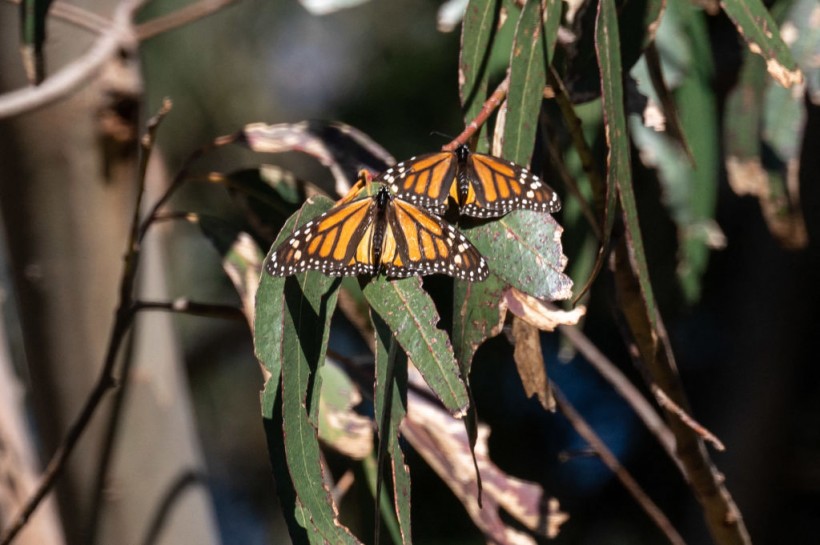Monarch butterflies are beautiful and iconic insects that migrate across North America every year.
They depend on milkweed plants and their relatives to complete their life cycle, as they lay their eggs and feed on the leaves of these plants.
However, not all milkweed plants are equally beneficial for monarchs, especially when they are infested by aphids.
What are aphids and how do they affect milkweed?
 (Photo : AMY OSBORNE/AFP via Getty Images)
(Photo : AMY OSBORNE/AFP via Getty Images)

Aphids are small, soft-bodied insects that suck the sap out of plants, causing them to wilt, deform, or die. They also secrete a sticky substance called honeydew, which attracts ants and other insects and can lead to the growth of black sooty mold on the plant surface, as per Phys.org.
Aphids can reproduce rapidly and form large colonies on the stems and leaves of their host plants.
One type of aphid that is particularly problematic for milkweed is the oleander aphid, which is native to the Mediterranean region and has spread worldwide.
This aphid prefers to feed on oleander and milkweed plants and can cause significant damage to them. Oleander aphids are bright yellow with black legs and cornicles (tailpipes) and can be easily spotted on the plants they infest.
Tropical milkweed, a non-native species of milkweed that is commonly planted in gardens across the southern U.S., is especially susceptible to oleander aphid attacks.
This type of milkweed has attractive red and yellow flowers that bloom throughout the year, and is often used to attract and support monarch butterflies.
However, unlike native milkweed species, tropical milkweed does not die back in the fall and winter, allowing aphids to persist on the plants year-round.
How do aphids affect monarch butterflies?
A recent study from the University of Florida found that when oleander aphids infested tropical milkweed plants, monarch butterflies laid fewer eggs on them, and caterpillars developing on those plants were slower to mature, as per Tallahassee Democrat.
The researchers grew tropical milkweed in a nursery setting, introducing aphids to one group of plants while keeping another group aphid-free.
They then released adult monarchs into the nursery and monitored their egg-laying behavior and caterpillar development.
The results showed that monarchs laid 40% fewer eggs on aphid-infested plants than on aphid-free plants.
Moreover, caterpillars that fed on aphid-infested plants took longer to reach pupation and had lower survival rates than those that fed on aphid-free plants.
The researchers speculated that the high levels of cardenolides, a toxic chemical compound in milkweed sap that protects the plant from herbivores, may have deterred monarchs from laying eggs on aphid-infested plants.
Cardenolides also make monarchs toxic to some predators, but too much of them can be harmful to the butterflies themselves.
Another issue with aphids on tropical milkweed is that they can increase the transmission of a parasite called Ophryocystis elektroscirrha (OE), which infects monarchs and reduces their fitness and survival.
OE spores are shed by infected adult monarchs when they land on or lay eggs on milkweed plants, and are ingested by caterpillars that feed on those plants.
The parasite then replicates inside the caterpillars and emerges with them as adults, weakening them and making them less likely to complete their migration.
Native milkweed species naturally die back in the fall and winter, removing any OE spores from the environment.
Tropical milkweed, however, stays green throughout the year, allowing OE spores to accumulate on the plant surface.
This means that monarchs that feed on tropical milkweed are more likely to encounter high doses of OE spores than those that feed on native milkweed species.
Also Read: Gray Whale and Monarch Butterfly Face Extinction with Dropping Population
What can we do to help monarchs and milkweed?
Monarch butterflies are facing many threats in their habitats, such as habitat loss, pesticide use, climate change, and disease.
Planting milkweed in gardens and urban areas can help provide food and shelter for these amazing insects, but it is important to choose the right kind of milkweed for your region.
Native milkweed species are adapted to local conditions and co-evolved with native insects and pollinators.
They also have natural cycles of growth and dormancy that match the seasonal patterns of monarch migration.
If you live in an area where tropical milkweed is widely available or already planted, you can still help reduce its negative impacts by following some simple steps:
- Cut back your tropical milkweed plants regularly throughout the year to remove any aphids or OE spores from the plant tissue.
- Replace your tropical milkweed plants with native species whenever possible. You can find native plant nurseries or seed sources online or in your local community.
- Educate yourself and others about the benefits of native plants and the challenges faced by monarch butterflies. You can join citizen science projects, such as the Monarch Larva Monitoring Project or the Monarch Health Project, to monitor and report on monarch populations and parasites in your area.
Related article: Butterfly Migration Revealed How Much the Monarch Population Grew Since Last Year
© 2024 NatureWorldNews.com All rights reserved. Do not reproduce without permission.




![Roundworms with Short Memories 'Stop Forgetting' When Frozen or Given Lithium [Study]](https://1471793142.rsc.cdn77.org/data/thumbs/full/70295/280/157/50/40/roundworms-with-short-memories-stop-forgetting-when-frozen-or-given-lithium-study.jpg)
